
- Home Page
- Accepted
Paintings & Copies - Doubtful
Attributions - Doubtful Textual References
- Alternative
Titles - Collectors &
Museums - Bibliography
- Search Abecedario
- Watteau &
His Circle
La Déclaration
Entered April 2020; May 2021
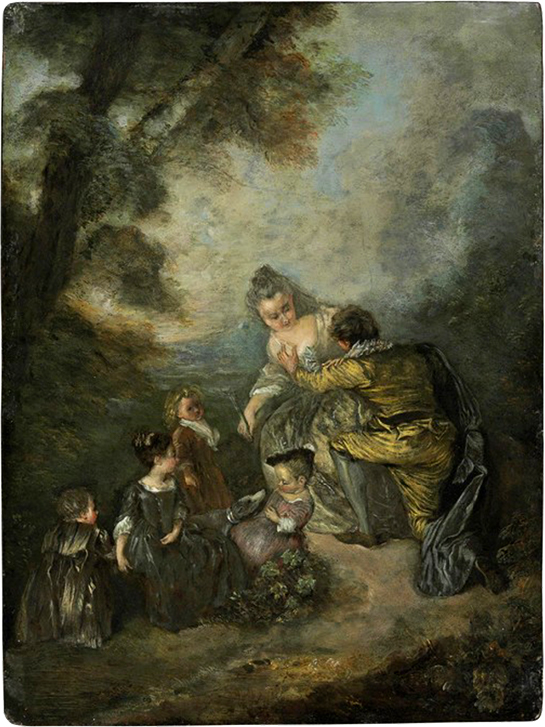
Whereabouts unknown
Oil on copper
21.9 x 16.4 cm
RELATED PRINTS
La Déclaration was not engraved for the Jullienne Oeuvre gravé.
PROVENANCE
Paris, collection of Louis Jean François Collet (chevalier de l’ordre de Saint Michel). His sale, Paris, May 14-23, 1787, cat. 94: “Watteau . . . L’Intérieur d’un Jardin, où l’on voit par le dos un jeune Homme un genou en terre aux pieds d’une jeune Fille, près d’eux quatre enfans sont grouppés en différentes attitudes. Haut. 7 pouc. 7 l. larg. 5 pouce. 10 lig. C.” Sold for 243 livres to Nicolas Lerouge
Paris, collection of Louis Robert de Saint-Victor (1738-1822; Conseiller du Roi, président en la Chambre des comptes, aides et finances de Normandie, conseiller honoraire en la Grand Chambre du Parlement de Rouen). His sale, Paris, November 26, 1822-January 7, 1823, lot 569: “WATEAU . . . Une Scène pastorale, dans laquelle, on voit un berger à genoux devant une bergère, qui semble refuser de l’entendre. Près d’eux, trois petits enfans jouent, l’un d'eux caresse un chien. Ce petit tableau est de la touche la plus spirituelle et la plus délicate. C. l.6 p. h. 8 p.” Sold for 63 francs to Jarmann.
London, collection of Samuel Rogers (1763-1855; poet). His sale, London, Christie’s, April 28, 1856, lot 676: “WATTEAU . . . A lady and gentleman, and a group of four children in a landscape—small.” Bought by Webb for £57.15.
London, collection of Rupert Clement George Carrington, 4th Baron Carrington (1852-1929; member of Parliament). His sale, London, Christies, May 9, 1930, lot 78: “A. Watteau . . A Lady and Gentleman, and a group of four children, in a landscape. / On copper-8 ½ in. by 6 in. / From the Collection of Samuel Rogers, Esq., 1856.” Sold for £899 to Glenn.
London, Christie’s, July 2, 1937, lot 80a: “WATTEAU . . . A Lady and Gentleman, with four children in a landscape. / On copper—8 ½ in. x 6 ¼ in. / From the Collection of Samuel Rogers, Esq., 1856 / From the Collection of Lord Carrington, 1930.” Sold for £315 to Bernard.
London, with Frank T. Sabin, c. 1953.
France, Private collection.Paris, sale, Hôtel Drouot Richelieu (Beaussant & Lefèvre), June 16, 2004, lot 51: “ÉCOLE FRANÇAISE DU XVIIIe SIÈCLE, d’après Antoine WATTEAU / La déclaration / Huile sur cuivre / 21,9 x 16,4 cm / Cadre en bois sculpté / €3 000 / 4 000” Sold for €48,000.
Belgium, Private collection.
New York, Christie’s, January 30, 2013, lot 37: “PROPERTY OF A EUROPEAN COLLECTOR / Antoine Watteau / La Déclaration / inscribed in ink 'A. Watteau' (on the reverse of the copper) / oil on copper / 8½ x 6¾ in. (21.9 x 16.4 cm.) / USD 500,000 - USD 700,000 / . . .
PROVENANCE . . . LITERATURE . . . .” Sold for $602,500.New York, Christie’s, April 19, 2018, lot 33: “PROPERTY OF A PRIVATE COLLECTOR / ANTOINE WATTEAU/ . . . La Déclaration / inscribed 'A. Watteau' (on the reverse of the copper) / oil on copper / 8 3⁄4 x 6 1⁄2 in. (22.1 x 16.4 cm.) / $400,000-600,000 / £290,000 / €330,000-490,000 / Provenance Collet collection, Chevalier de l'ordre de Saint-Michel, Paris; his sale, 14-23 May 1787, lot 94. Robert de Saint-Victor, Conseiller au Parlement, Président de la Chambre des Comptes de Rouen, Paris; sale, 26 November 1822-7 January 1823, lot 569. Samuel Rogers, London; Christie's, London, 3 May 1856, lot 676 (to Webb). Webb collection, London. Lord Carrington, London; Christie's, London, 9 May 1930, lot 18 (to Bernard). Private collection, France. Private collection, Belgium. Private collection, Europe; Christie's, New York, 30 January 2013, lot 37, where acquired by the present owner. . . .” Sold for $468,5000.
SELECT BIBLIOGRAPHY
Goncourt, Catalogue raisonné (1875), 159, 161.
Ingamells, Hertford Mawson Letters (1981), 75.
Roland Michel, Watteau (1984), 298-99.
Whittingham, “Watteaus and ‘Watteaus’” (1987), 272.
Rosenberg and Prat, Watteau, Catalogue raisonné des dessins (1996), cat. 229, 504, 508, G 12.
Wintermute, "Surprise! Surprise!" (2012).
RELATED DRAWINGS
There are a number of drawings that are indirectly related to La Déclaration. They were previously employed for L’Assemblée galante—a painting known only through the engraving in the Jullienne Oeuvre gravé. The drawings apparently were not consulted again for La Déclaration. Rather, Watteau based the second painting on his previous canvas.
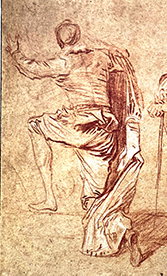
Watteau, Four Studies of a Man with a Cape (detail), red and white chalk, Paris, Musée du Louvre, Département des arts graphiques.
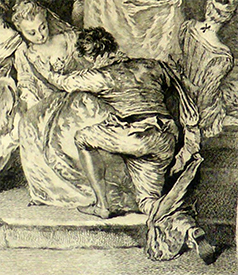
Jacques Philippe Le Bas after Watteau, L’Assemblée galante (detail), engraving.
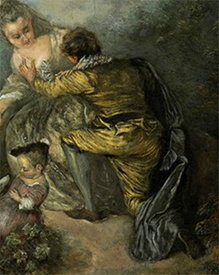
Watteau, La Déclaration (detail).
Watteau’s initial study for the kneeling man (Rosenberg and Prat 504) was rendered rapidly, but the incomplete areas were further resolved in the painting. All the details of the man’s head and hair, left arm, and left leg—as depicted in L’Assemblée galante—were repeated in La Déclaration. This is evidence of the order and process that Watteau followed.
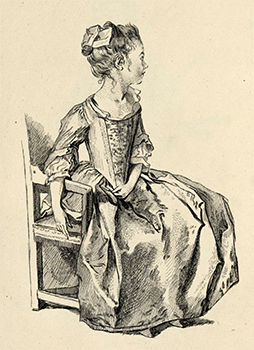
François Boucher after Watteau, Study of a Young Girl Seated in a Chair (detail), Figures de différents caractères, plate 37 (here reversed).
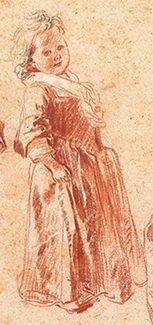
Watteau, Three Studies of Girls (detail), red, black and white chalk. Whereabouts unknown.

Watteau, Sheet with a Miscellany of Studies (detail), red, black, and white chalk. Paris, Musée du Louvre, Département des arts graphiques.
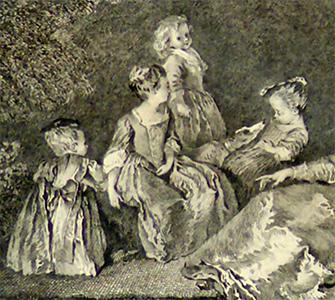
Jacques Philippe Le Bas after Watteau, L’Assemblée galante (detail, here reversed), engraving.
Three of the children depicted in La Déclaration are ultimately based on known Watteau drawings. The seated child, her arm resting limply in her lap, is based on a lost drawing recorded in plate 37 of the Figures de différents caractères. The child farthest back, looking over her shoulder, is dependent on a drawing in the Louvre (Rosenberg and Prat 508) . Finally, the child in the foreground, playing with a dog, can be traced to a Watteau drawing in the Louvre (Rosenberg and Prat 229).
However, certain details show that when Watteau was painting La Déclaration he did not turn to his original drawings but, rather, copied them from L’Assemblée galante. Most importantly, he retained the identical relationship between the individual figures that he established in L’Assemblée galante, and this was something that could not have been transmitted through his drawings. This is corroborated by certain details. For example, the seated young girl in the original drawing holds some sort of cloth, but in L’Assemblée galante and then again in La Déclaration, she holds a nuzzling dog.
REMARKS
In part, the previous obscurity of this composition can be attributed to the fact that it was not included in Jullienne’s Oeuvre gravé. Despite its passage in several public sales in the eighteenth and nineteenth centuries, the picture elicited no mention by Watteau scholars. In 1930 and again in 1937, when the painting sold at auction, it still did not gain a foothold in the literature on Watteau. When the London dealer Frank T. Sabin owned the picture in 1953, he described it as “a work not so important.” Sabin’s ownership, not previously noted in the picture’s provenance, is documented by a letter from him, dated June 25, 1953, to Hélène Adhémar and now in her unsorted material filed under “Watteau” in the Service de documentation, Département des peintures. In this letter he did not explicitly name the painting but he described it fully, including a mention of the engraving on the reverse side of the copper plate, its provenance from the Earl of Harrington [sic], and its measurements of 8 ½ x 6 ¼ inches. Obviously he was trying to sell it to the Louvre but met with no success.
In the second half of the twentieth century, scholars consistently passed over it in silence, and when it came up for sale in 2004, it was described only as “after Watteau” but brought a good price. Christophe Janet has the honor of correctly recognizing it to be by Watteau. Then, after the picture appeared at auction in 2013 and brought a record sum, it was unanimously accepted as an authentic work. Rightly so. Despite its poor condition, it still possesses the scintillating brushwork and impetuosity of touch that are the artist’s hallmarks.
The picture is painted on a sheet of copper, which is not unheard of in Watteau’s oeuvre. His two military pictures in the Hermitage, Les Fatigues de la guerre and Les Délassements de la guerre, are painted on copper, and so too are the fêtes galantes in Troyes, L’Enchanteur and L’Avanturière. However, the copper plate for La Déclaration had first been used by another artist, one who began an etching of a Virgin and Child and then abandoned the project. That Watteau used a second-hand support is something encountered elsewhere in the artist’s oeuvre. Both his L'Accord parfait in Los Angeles and La Sérénade italienne in Stockholm were painted on discarded coach doors. Why Watteau was so economy-minded is not clear, but he was.
Copper is a strong support but it poses its own problems. Paint flakes from it and it is easily scratched. The surface of La Déclaration shows that it has not escaped these weaknesses. The paint is uneven, in parts it looks too thinly painted, in other parts—such as the foliage—it appears overpainted.
The dating of this work rests on the dating of its source, L’Assemblée galante. That painting is generally dated somewhere between 1716 and 1718, with predictable differences from one scholar to the next. In theory, then, La Déclaration should be dated 1716-18 or only slightly later.